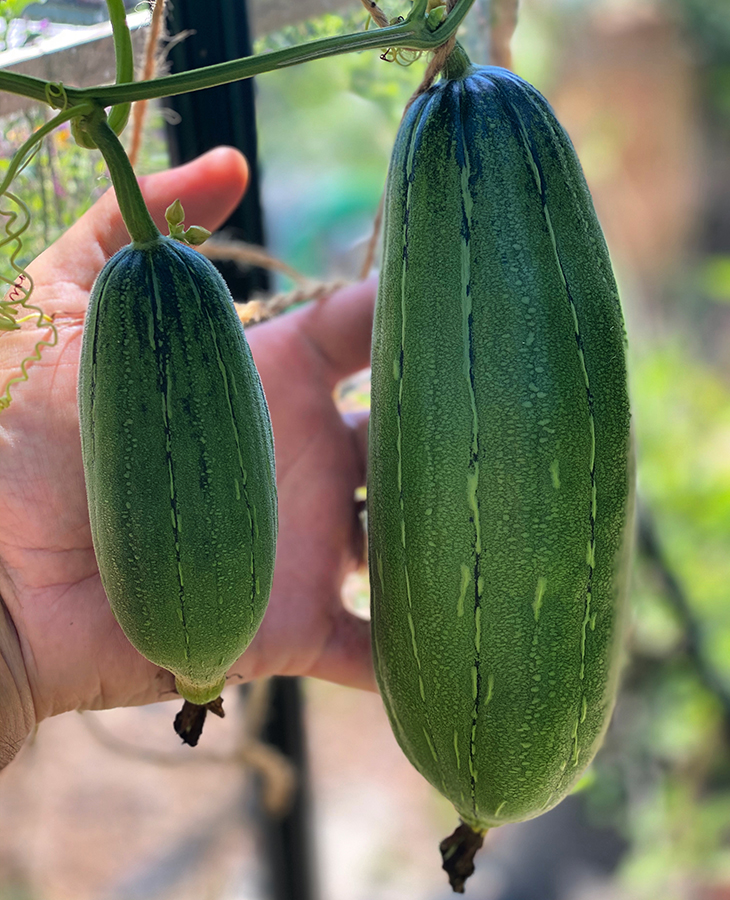They’re best known as back scrubbers, for use in the bath or shower, but luffas, aka loofa and loofah, are also tipped to be among the must-have plants to grow this year, in an effort to help ditch unnecessary plastic.
“When you mention ‘loofah’ to people, 90 per cent of people think they’re a sponge that grows in the sea,” says keen grower Rob Smith.
“There are so many newcomers to gardening and a lot of them are looking for something different to grow,” observes Mr Smith.
Read more: How garden trends are changing post-pandemic
So, how do you go about growing them? Mr Smith explains.
Luffas belong to which family?
They are a gourd, native to south and southeast Asia and are grown in conditions similar to greenhouse cucumbers.
What conditions do they need?
They need warmth, so you’ll need a heated greenhouse or suitable windowsill on which to sow the seeds or grow the young plants. They can take two or three weeks to germinate. Ideally the seeds should be sown in a heated propagator, or a warm spot on a windowsill.
Pot them in, adding pea sticks or canes for the tendrils to grab on to as they grow, until you can transfer them to an unheated greenhouse when all danger of frost has passed.
If they seem to be growing too quickly in your home before you can transfer them, you can slow them down by leaving them in their pots, so their roots are restricted.
Read more: How to create a garden when space is limited
How long do they take to grow?
Luffas are best grown as a summer annual. In the wet tropics they grow vigorously, but in Tasmania for best results grow them in a glass house. Sow the seed in spring after all chances of frost have passed and give them a moist, fertile, freely draining soil, full sun and a sturdy support for their tendrils.
It’s a long season. Once the plant starts growing, it grows quickly, but can be cut back if it gets out of control. They can grow extremely tall – to more than 3m (10ft) – and will fill any space you give them.
I grow them in big pots of multipurpose compost, as I would do cucumbers or tomatoes, but they’ll need to be spaced around 45-60cm apart. They will grow into each other.
Do you need to prop them up?
Yes. They will need netting, canes or wires to climb up, but they won’t need little hammocks underneath them, as you would with melons, because the stem is quite tough and as they become more fibrous, they get lighter.
What about pollination?
I leave my greenhouse doors open in the day and then close them at night, so the insects will have done their work.
Can you eat them?
Yes, they are just like a climbing zucchini or pumpkin. The foliage looks more like a fruit, but the luffa has a beautiful big yellow flower the size of the palm of your hand, a bit like a zucchini flower but a bit daintier.
The first few flowers don’t set, but once they start setting you can eat them, until they are 13-15cm (5-6in) long, using them like you would a zucchini. They look like zucchinis, although they are not as smooth-skinned, and are lighter than a dark zucchini.
Read more: Rick Stein’s Autumnal Vegie Soup
How do you maximise the crop?

If you want to eat them, harvest them small. Leave, say, three to grow on each plant to become the big luffa. Once they reach more than 15cm long you wouldn’t want to eat them because the inside starts to form the fibrous skeleton.
As it develops, it starts to look almost like a marrow. If you grow them well, they can be as thick as your forearm.
How do you know when the luffa is ready to harvest?
Leave it on the plant until the plant starts dying back in late summer and early autumn, when the foliage starts to go brown.
The luffa will start to go to a brown-khaki colour and you see it physically dehydrating as the skin wrinkles and the fruit becomes light. Cut them off and leave them in a dry shed to dehydrate a bit more, then when the skin is almost crispy you can peel it off or submerge them in a bucket of water, which helps the skin come off more easily.
Then you have your luffa, but you need to shake it to remove the hundreds of seeds inside. Its natural colour is off-white; the pure white ones you see in shops are often bleached.
What can you use it for?
Obviously, you can use it when you have a bath or shower to exfoliate and remove dead skin, but you can also slice it thickly into rings and use it as pan scrubs instead of metal or plastic-based pan scouring pads. Some people even fill the thick-cut luffa circles with home-made soap and give them as Christmas gifts.
How do you dispose of them?
The whole plant and spent luffas can be put on the compost heap where they will degrade naturally.
What efforts have you made to be more sustainable? Are you going to grow your own loofah sponge?
– With PA
If you enjoy our content, don’t keep it to yourself. Share our free eNews with your friends and encourage them to sign up.

